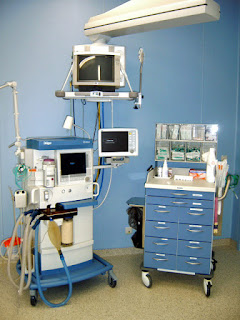 |
| Modern equipment for general anesthesia. Source: M Ansorena, CC2.5 license |
General anesthesia is used to put a patient under for surgery and other invasive medical or dental procedures. This type of anesthesia is a combination of intravenous and inhaled medicines, which may not be suitable for all patients and procedures. The drugs of choice for anesthetic purposes have changed over the years as advances have shown more effective ways of achieving unconsciousness and pain relief with fewer side effects and complications.
But the gases that have been used over the years, and are still used, do have side effects.Read more after the jump.
General anesthesia is used to, as commonly said, “put a patient under” for surgery and other invasive medical or dental procedures. As explained by Dr. Arjun Desai and colleagues for Medscape, general anesthesia is a reversible state of unconsciousness in which the patients can tolerate otherwise unbearable pain without remembering that they experienced it at all. General anesthesia is a combination of intravenous and inhaled medicines, which may not be suitable for all patients and procedures. The National Library of Medicine offers a guide to determining your risk factors for a reaction and what your anesthesiologist needs to know about you.
Gases used in general anesthesia
The drugs of choice for anesthetic purposes have changed over the years as advances have shown more effective ways of achieving unconsciousness and pain relief with fewer side effects and complications. For surgery, induction agents (the chemical that induces unconsciousness) were once given as inhaled vapor, but then replaced by intravenous agents, especially in adults. However, Dr. Desai points out that inhaled induction agent use in surgery is making a comeback. Dentistry uses a much more mild form of anesthetic, without the paralyzing agents, though many dental practices have also opted for intravenous sedation.
The commonly used gas in surgery today is sevoflurane. However, a number of other similar gases may also be used. Nitrous oxide is the oldest used anesthetic, most commonly associated with the dentist’s chair. Halogenated agents (specifically chlorofluorocarbons), were then introduced, but they may be mixed with nitrous oxide. Halothane was the first, replaced by isoflurane and enflurane in the 1980s, and desflurane and sevoflurane in the 1990s.
Side effects of nitrous oxide
Nitrous oxide (NO2) is sometimes referred to as ‘laughing gas’. NO2 is given alongside oxygen to avoid hypoxia (low oxygen in the blood). This NO2-O2 mix causes warm sensations and feelings of euphoria. At sedation levels it causes unawareness and sleepiness. With oversedation nausea occurs.
Nitrous oxide inactivates an enzyme necessary for DNA synthesis, methionine synthase, potentially causing tissue damage. This reaction is rare and usually associated with long-term use. Most damage is seen in the blood forming tissues and central nervous system of patients deficient in B12.
Side effects of halogenated agents
Brain: Scientists and doctors still are not sure exactly how anesthetics work, but they know that they affect a number of receptors in the brain in order to induce the unconscious state and prevent the patient from feeling pain. Seizures and agitation have been reported with sevoflurane use, but the patients were likely already at risk of seizures.
Lungs and circulation: The inhaled gases may irritate the respiratory system. Some patients may cough or exhibit breath holding or throat spasms. The airway irritation is not seen with sevoflurane, but opioids appear to decrease its occurrence with other gases. Heart rate and blood pressure may increase or decrease with increased doses of particular gases, which is why anesthesiologists closely monitor patients during procedures.
Other organs: The chemicals degrade while in the body, leading to potentially toxic metabolites if not chosen or controlled properly. As explained by Medscape News, ‘Compound A’ is one such metabolite. This compound has been identified as a nephrotoxin in animals, though damage to the kidneys is rare in humans. Nephrotoxicity with the use of sevoflurane is avoided by limiting the time under anesthesia. Similarly, desflurane, isoflurane and halothane are metabolized to trifluoracetate, which can cause hepatotoxicity. The liver damage is induced by an immune reaction to the compound. However, according to Medscape News very few cases of tissue injury have been reported for gases used in general anesthesia, and they may even be protective against other surgical complications, like hypoxia.
Common side effects of general anesthesia
Nausea and vomiting were once common side effects of general anesthesia, but the newer agents and mixtures pass more quickly from the bloodstream and are better controlled, reducing side effects. As you come out of any form of anesthesia, a sleepy confused state is normal until fully awake.

No comments:
Post a Comment